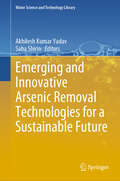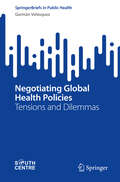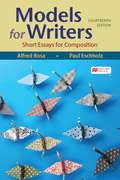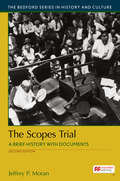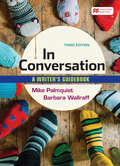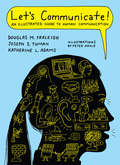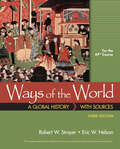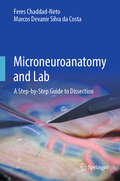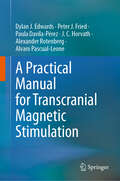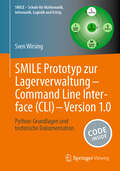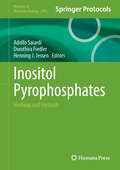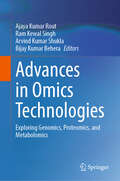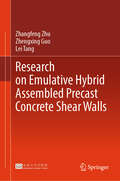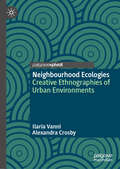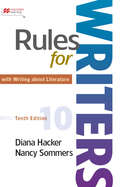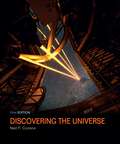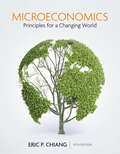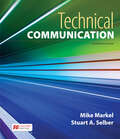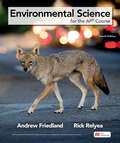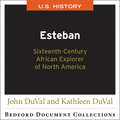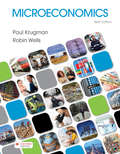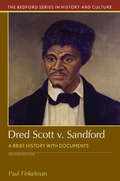- Table View
- List View
Emerging and Innovative Arsenic Removal Technologies for a Sustainable Future (Water Science and Technology Library #131)
by Akhilesh Kumar Yadav Saba ShirinThis book presents an overview of the techniques available today to remove arsenic contamination, pollutants, and species from water. Traditionally applied techniques for removal of arsenic pollutants/species, including oxidation, coagulation-flocculation, and membrane techniques. Furthermore, recent progress has been made on the utility of various nanoparticles for the extraction of contaminated water. Arsenic contamination affects the quality of water resources worldwide as a result of human activities (pesticides and other uses). Due to the insufficiency of water treatment facilities in developing countries, oral exposure to chemical toxicants through drinking water is a health threat. Arsenic is a mobile element with a crustal abundance of 1.8 mg kg-1 and can travel in different components of the environment, including air, soil, and water before entering into its ultimate sink, that is, bottom sediments and sea. Arsenic may enter groundwater from both geogenic and anthropogenic sources and primarily exists in inorganic form as oxy-anions. Groundwater is relatively more vulnerable to arsenic contamination from geothermal inputs, including the weathering and dissolution of arsenic-bearing rocks and minerals. Arsenic mobility is enhanced in subsurface anoxic conditions, making groundwater more vulnerable to arsenic contamination. Ingestion of groundwater-laden arsenic may cause carcinogenic and non-carcinogenic health ailments. Chronic oral exposure ≤ 50 µg L-1 of arsenic can cause skin lesions, skin cancer, melanosis, hyperkeratosis, hypertension, gangrene, cardiovascular problems, black foot disease, neuropathy, peripheral vascular disease, restrictive lung disease, bladder cancer, lung cancer etc. Hence, specific water treatment processes are required to meet anticipated more severe water quality standards. A better understanding of currently available processes is necessary to develop economical, efficient and effective methods for arsenic removal. Arsenic can be coated, adsorbed using a wide range of mineral and organic or can be directly rejected by membrane processes such as reverse osmosis and nanofiltration. The recent development of submerged hybrid membrane systems, such as membrane bioreactors in wastewater treatment, provides alternative technologies for arsenic treatment.
Negotiating Global Health Policies: Tensions and Dilemmas (SpringerBriefs in Public Health)
by Germán VelásquezThis book presents reflections and research that highlight tensions in the ongoing negotiations on pandemic preparedness treaties and revisions to the International Health Regulations, underscoring the geopolitical divide between developed and developing countries. It advocates regional health initiatives as a response to the multilateral impasse and reflects on the erosion of foundational public health concepts such as "essential medicines". New pandemics are inevitable. How can we best prepare for them and, above all, how can we avoid the mistakes and injustices made during the COVID-19 pandemic? Negotiations are underway to formulate a binding international treaty on prevention and preparedness to ensure fairer responses to future pandemics. This book is intended as a critical contribution to the current debates. How can equitable access to medicines and diagnostics be guaranteed when they are produced in a small number of countries? How can we explain the fact that current funding for cooperation in the field of health is in the hands of a small group of Northern countries and foundations from the North? How can the role of the World Health Organization be strengthened? WHO now plays only a minor role in coordinating public health policies. How is it that the concept of &“essential medicines&”, a major advance in public health policy, is being replaced by that of &“medical countermeasures&”, a term more in line with the private sectors? Preparing for future pandemics forces us to ask ourselves: how can we safeguard the general interest, the defense of human rights and public health? Negotiating Global Health Policies: Tensions and Dilemmas is essential reading for negotiators from the 194 member countries of the World Health Organization (WHO), the World Trade Organization (WTO), and the World Intellectual Property Organization (WIPO) who participate in international negotiations on health and development. Academics and students of medicine, health sciences, law, sociology and political science, as well as intergovernmental organizations and non-governmental organizations who work on access to medicines and global health issues, also would find the book of interest.
Introduction to Fourier Optics (Mcgraw-hill Series In Electrical And Computer Engineering)
by Joseph GoodmanFourier analysis is a ubiquitous tool that has found application to diverse areas of physics and engineering. Goodman focuses on applications in optics, and in particular with applications to diffraction, imaging, optical information processing, holography, and optical communications. Goodman, Introduction to Fourier Optics satisfies the needs of several different types of Physics and Engineering courses. Directed towards both physicists and engineers this text is suitable for audiences focusing on applications of optics. A clear presentation makes this text work well as both a teaching resource and a reference book.
Models for Writers: Short Essays for Composition
by Paul Eschholz Alfred RosaModels for Writers provides brief, compelling readings similar in length to the essays you’ll be assigned to write in college. Step-by-step advice for writing includes definition, compare and contrast, and more, with additional coverage of the elements of the essay, using sources, and research papers.
The Scopes Trial: A Brief History with Documents (The\bedford Series In History And Culture)
by Jeffrey MoranThe Scopes Trial, 2e, by Jeffrey Moran explores the history of this pivotal 1920’s trial complete with accessible headnotes for each primary source document.
In Conversation: A Writer's Guidebook
by Mike Palmquist Barbara WallraffIn Conversation helps you think critically about why you’re writing and who you’re writing to while preparing you for all the kinds of writing you need to do.
Let's Communicate: An Illustrated Guide to Human Communication
by Douglas Fraleigh Joseph Tuman Katherine AdamsLet’s Communicate is everything you want in a human communication text—substantive, engaging, and fun. Created by communication scholars Douglas Fraleigh, Joseph Tuman, and Katherine Adams, Let’s Communicate takes their combined 100 years’ worth of research and teaching experience to present all the basic human communication concepts with unique attention paid to technology, culture, gender, and social justice. The authors provides provocative, real-life examples and a special focus on skills that together make communication meaningful for students both in and out of the classroom—all at an affordable price. Let’s Communicate is also the first human communication text to use hundreds of hand-drawn illustrations that help students understand and retain important concepts. These unique and often humorous illustrations present concepts in graphic form (especially helpful for visual learners), make complex ideas easier to understand, provide hooks to help students remember material, extend concepts, and generate discussion.
Ways of the World with Sources for the AP® Course
by Robert Strayer Eric NelsonWays of the World is the ideal textbook for your redesigned AP® World History classroom. Like the AP® course it supports, Ways of the World focuses on significant historical trends, themes, and developments in world history. Authors Robert Strayer and Eric Nelson provide a thoughtful and insightful synthesis that helps students see the big picture. Each chapter then culminates with collections of primary sources organized around a particular theme, issue, or question, allowing students to consider the evidence the way historians do.
Microneuroanatomy and Lab: A Step-by-Step Guide to Dissection
by Feres Chaddad-Neto Marcos Devanir CostaDetailed knowledge of nervous system anatomy and microsurgical training in the laboratory are essential to understanding the brain. This practical book introduces the Neuroanatomical Lab for medical students, neurosurgical and neurology residents, and neurosurgeons. It addresses all the basic tenets of the laboratory routine, specimens&’ preparations and also details all types of brain dissections. How to build a Microneurosurgical Lab? How to prepare models for microsurgical training? How to start the Lab Training? How to dissect the important anatomical regions of the brain? All of these questions are discussed in the 15 didactic chapters and are richly illustrated by images. More than an educational manual, this is a fascinating step-by-step guide to starting the anatomical dissection of the brain and for microsurgical training. From basic to advanced, this work reflects the authors extensive experience, making it an indispensable tool for students and practitioners interested in understanding the brain in-depth.
A Practical Manual for Transcranial Magnetic Stimulation
by Alvaro Pascual-Leone Alexander Rotenberg Dylan J. Edwards Peter J. Fried Paula Davila-Pérez Jared C. HorvathThis practical guide to transcranial magnetic stimulation (TMS) offers step-by-step instruction for the most commonly used TMS protocols in humans. TMS equipment is increasingly available in University and Hospital settings and even small clinics. TMS protocols are often taken from disparate publications, and there has not been a single comprehensive and practical reference for the most common procedures. The current book contains structured steps for the various TMS protocols in addition to relevant fundamental information, including a practical summary of principles of TMS and a glossary of terms. This book is designed to be a quick reference on the office or clinic desk, or in the laboratory, and would be as useful for guiding research and clinical laboratory activities as it would for deciphering TMS study methodologies in the literature.
SMILE Prototyp zur Lagerverwaltung - Command Line Interface: Python-Grundlagen und technische Dokumentation (Schule für Mathematik, Informatik, Logistik und Erfolg)
by Sven WirsingDieses Buch ermöglicht einen Einstieg in die ,Programmiersprache Python&‘. Hierzu werden die zum Verständnis des ,SMILE-CLI-Prototypen&‘ notwendigen ,Python-Grundlagen&‘ allgemein und mittels Beispiele sowie Python-Programmen erläutert. Neben der theoretischen Erarbeitung der wesentlichen Grundlagen erlaubt dies sofort erste praktische Programmiererfahrungen mit Python zu gewinnen. Deshalb stehen alle verwendeten Beispielprogramme auch zum Download bei ,Springer-Link&‘ für Sie bereit und können von Ihnen nach Belieben abgeändert werden. Der Inhalt orientiert sich im ,Grundlagen-Kapitel&‘ an Themen, die zum Verständnis der CLI-Version des SMILE-LVS-Prototypen benötigt werden. Hierzu zählen etwa der Umgang mit dem ,Spyder-Editor&‘, die Arbeit mit ,Paketen&‘, die Unterscheidung von ,Hauptprogramm&‘ und ,Unterprogramm&‘, die Befehle zur Eingabe und Ausgabe in der ,User-Kommunikation&‘, der Umgang mit und das Zuweisen von ,Variablen&‘, die Verwendung von ,Python-Datentypen&‘, das Programmieren logischer Ausdrücke, der Nutzen von Schleifen und Datenstrukturen, die Erzeugung von ,Zeitstempeln&‘ und ,Zufallszahlen&‘, der Umgang mit ,CSV-Dateien&‘, PDF-Dokumenten&‘ und ,QR-Barcodes&‘, der Umgang mit ,Ausnahmebehandlungen&‘, die Klassifikation von ,Bugs&‘, ,Debugging&‘ und ,Bugfixing&‘, die Zugriffe auf ,Pfade und Dateien&‘ sowie der Umgang mit ,Klassen und Methoden&‘. Der zweite Baustein dieses Buches ermöglicht detaillierte Einblicke in die ,Programmierung des CLI-LVS-Prototyps&‘. Zunächst werden die Konzeptionierung und der Ablauf aller Unterprogramme, Klassen und des Hauptprogramms schematisch dargestellt. Es wird detailliert auf die ,Datenbasis in Form von CSV-Dateien&‘ eingegangen, mit der alle notwendigen ,Stamm- und Bewegungsdaten&‘ erfasst, bearbeitet und ausgewertet werden. Nachfolgend wird auf den ,Programmcode des CLI-LVS-Prototyps&‘ eingegangen. Alle ,Unterprogramme&‘, alle ,Klassen&‘ und alle ,Methoden&‘ sowie das ,Hauptprogramm&‘ sind mit ihrem jeweiligen ,Programmcode&‘ aufgeführt. Zum Verständnis des Codes ist in jeder Zeile ein zugehöriger ,Kommentar&‘ hinzugefügt, der die Code-Zeile explizit erläutert. Alle benutzten ,Python-Befehle&‘ sind für jeden Abschnitt aufgelistet.
Artistic Practices, Participation and Politics
by Hugo Cruz"I know of no other empirical study of community arts that is so widespread and executed so thoroughly." --Eugene Van Erven, Utrecht University, Netherlands The book focuses on participatory artistic practices, with South of Europe and Latin America as the central geographical context for analysis. The book aims to redefine and explore key concepts such as community art practices, civic and political participation, and cultural and artistic involvement. Through in-depth case studies, the work (re)examines the elements of community artistic practices and the quality of artistic and cultural participation, particularly in the context of Brazilian and Portuguese theatre groups.
Inositol Pyrophosphates: Methods and Protocols (Methods in Molecular Biology #2972)
by Adolfo Saiardi Dorothea Fiedler Henning J. JessenThis detailed volume explores methods that reflect the explosion of interest in the important cellular messengers known as inositol pyrophosphates. After a brief historical perspective of the analytical approaches that have contributed to the development of this research field, the book collects methods that cover isolation, detection, and measurement of inositol pyrophosphates, followed by approaches to ascertain their mechanism of action, as well as a description of the use of experimental models that have been instrumental to many fundamental discoveries. Written for the highly successful Methods in Molecular Biology series, chapters include introductions to their respective topics, lists of the necessary materials and reagents, step-by-step and readily reproducible laboratory protocols, and tips for troubleshooting and avoiding known pitfalls. Authoritative and practical, Inositol Pyrophosphates: Methods and Protocols serves as an ideal guide for researchers attempting to further our knowledge of this vibrant area of study.
Advances in Omics Technologies: Exploring Genomics, Proteomics, and Metabolomics
by Bijay Kumar Behera Ajaya Kumar Rout Ram Kewal Singh Arvind Kumar ShuklaThis comprehensive volume offers an in-depth exploration of the latest advancements in omics technologies and their practical applications across environmental science, agriculture, healthcare, and biotechnology. Covering key topics such as metagenomics for identifying beneficial microbes, bioremediation for environmental cleanup, bacteriophages, proteomics, epigenomics, and CRISPR-Cas9 genome editing, the book provides valuable insights into cutting-edge tools and methodologies. It also delves into next-generation sequencing, biosensor technology, bioinformatics tools, mass spectrometry-based metabolomics, as well as emerging fields like nutrigenomics and microarrays technology. With clear explanations and practical perspectives, this authoritative resource is ideal for students, researchers, and professionals striving to stay abreast of innovations in life sciences and contribute to the rapidly evolving landscape of omics sciences.
Research on Emulative Hybrid Assembled Precast Concrete Shear Walls
by Lei Tang Zhangfeng Zhu Zhengxing GuoThis book proposes a novel precast concrete shear wall, named hybrid precast concrete shear wall, which is assembled by post-tensioned unbonded prestressed technology, local unbonded technology of grouted reinforcement and overlapping closed stirrup technology. Based on collected data from pseudo-static testing on nine full-scale specimens, the numerical analysis is conducted, and corresponding design method is put forward. Furthermore, several structural improvement measures are discussed, and the optimal scheme is determined. The book focuses on the seismic performance of proposed hybrid precast concrete shear wall and establishes the design method and optimal structural detail to guide engineering practice. The book is intended for researchers, design engineers, college teachers and students, who are working on/studying precast concrete shear wall structure.
Neighbourhood Ecologies: Creative Ethnographies of Urban Environments
by Ilaria Vanni Alexandra CrosbyThis book foregrounds socioecological stewardship in urban spaces. It demonstrates how activities like gardening and participating in events that spark ecological learning foster a sense of place, social connections, and lively neighbourhoods. Offering case studies from Sydney, Australia, it presents an innovative, interdisciplinary, place-based design research methodology. This approach combines ethnography to examine people-place-environment relationships with design’s potential for creating change through artefacts and initiatives like maps, curated walks, and workshops. The book contributes to methodological debates by showcasing how visual communication and socially engaged practices strengthen ethnographic understandings of society, culture, and the environment. The authors show that these practices connect everyday environmental actions to broader contexts, such as making cities liveable during climate change, aligning with the United Nations' Sustainable Development Goal 11: Sustainable Cities and Communities. Neighbourhood Ecologies offers key insights for scholars and students of urban sociology, human geography, anthropology, design studies, and social movement studies interested in how critical environmental issues become grounded in local contexts.
Rules for Writers with Writing about Literature
by Diana Hacker Nancy SommersRules for Writers with Writing about Literature supports students from a wide range of backgrounds with accessible explanations, step-by-step advice, class-tested examples, and opportunities to practice and build their writing, grammar, and research skills—all at a tremendous value.
Discovering the Universe: From The Stars To The Planets
by Neil Comins William KaufmannCombining a student-centered approach with the reliability of a familiar and proven text, Discovering The Universe invites students to follow their curiosity and ask questions about astronomy, through features including What If? questions that explore alternative solar systems and universes and Meet the Discoverer interviews with working scientists throughout the text.
Microeconomics: Principles for a Changing World
by Eric ChiangWith this edition, Eric Chiang continues to link economics concepts to topics of personal interest to students. The new edition is a thoroughly contemporary, fully integrated print/technology resource that adapts to the way you want to teach. As always, this concise book focuses on the topics most often covered in the principles course, but with this edition, it offers a stronger emphasis than ever on helping students apply an economic way of thinking to the overwhelming flow of data we face every day. Economics: Principles for a Changing World is fully informed by Eric Chiang’s experiences teaching thousands of students worldwide, both in person and online. Developing the text, art, media, homework, and ancillaries simultaneously, Chiang translates those experiences into a cohesive approach that embodies the book’s founding principles: To use technology as a tool for learning—before lectures, during class, when doing homework, and at exam time To help students harness the data literacy they’ll need as consumers of economic information
Technical Communication
by Mike Markel Stuart SelberMake the leap from writing in college to writing in a variety of workplace settings and contexts with Technical Communication. Practical advice and real-world examples let you practice with the kinds of writing processes and products you’ll encounter on the job.
Environmental Science for the AP® Course
by Andrew Friedland Rick RelyeaFriedland/Relyea helps students gain the knowledge and skills needed to succeed on the AP® exam.
Esteban: Sixteenth-Century African Explorer of North America
by Kathleen DuVal John DuValThe documents in this collection introduce the story of Esteban, one of the first people of African descent to visit what today is the United States. Students will engage with a wide range of primary sources, constructing an argument based on the central question: What do descriptions of Esteban’s explorations tell us about slavery, race, and first encounters in sixteenth-century North America? Given the limited nature of these sources, what can we never know? Students are guided in their analyses of the documents by a learning objective, central question, historical background, source headnotes, source questions, project questions and suggestions for further research. Through their work with these sources, they will gain a deeper awareness of the diversity of the American experience, a more complete understanding of the present in an historically-based context, an enhanced ability to read, interpret, assess, and contextualize primary sources, and practice explaining historical change over time.
Microeconomics
by Paul Krugman Robin WellsWith its signature storytelling style and coverage of current issues and events, Nobel laureate and New York Times columnist Paul Krugman and co-author, Robin Wells’s best-seller is the most effective textbook available for explaining how economic concepts play out in our world. This new edition offers incisive new insight into market power and externalities in microeconomics, updated analysis of long-run growth, and extensive coverage of the economic impacts and policy responses to the coronavirus pandemic in macroeconomics
Dred Scott v. Sandford: A Brief History with Documents
by Paul FinkelmanPerhaps no other Supreme Court decision has had the political impact of Dred Scott v. Sandford. Using a variety of documents that reflect regional opinions and political debates, Paul Finkelman examines the 1857 decision that helped set in motion the events that eventually led to a new birth of freedom and the abolition of slavery in the United States. A revised Introduction reveals new understandings of the case and recently discovered evidence about Dred Scott, his wife Harriet, his owners, his lawyers, and the history of freedom suits in Missouri. New text sources include President James Buchanan’s inaugural address and the post-Civil War Amendments, which collectively reversed the major holdings in Dred Scott. This new edition also contains Questions for Consideration, an updated Selected Bibliography, and a Chronology of Events Related to Dred Scott.
Symbolic Dynamical Systems and C*-Algebras: Continuous Orbit Equivalence of Topological Markov Shifts and Cuntz–Krieger Algebras (Mathematical Physics Studies)
by Kengo MatsumotoThis book presents the interplay between topological Markov shifts and Cuntz–Krieger algebras by providing notations, techniques, and ideas in detail. The main goal of this book is to provide a detailed proof of a classification theorem for continuous orbit equivalence of one-sided topological Markov shifts. The continuous orbit equivalence of one-sided topological Markov shifts is classified in terms of several different mathematical objects: the étale groupoids, the actions of the continuous full groups on the Markov shifts, the algebraic type of continuous full groups, the Cuntz–Krieger algebras, and the K-theory dates of the Cuntz–Krieger algebras. This classification result shows that topological Markov shifts have deep connections with not only operator algebras but also groupoid theory, infinite non-amenable groups, group actions, graph theory, linear algebras, K-theory, and so on. By using this classification result, the complete classification of flow equivalence in two-sided topological Markov shifts is described in terms of Cuntz–Krieger algebras. The author will also study the relationship between the topological conjugacy of topological Markov shifts and the gauge actions of Cuntz–Krieger algebras.
